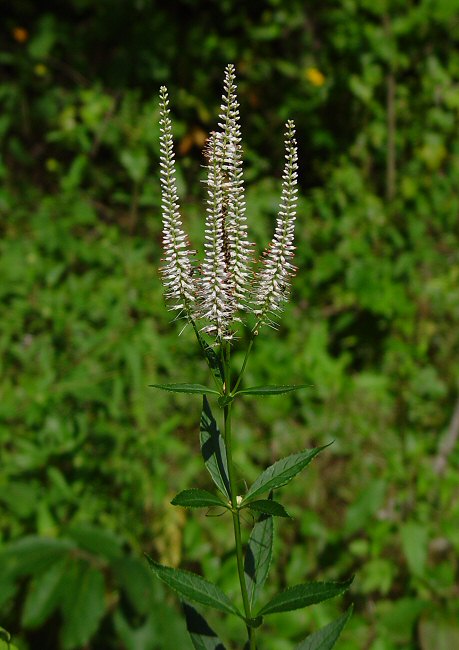Veronicastrum virginicum (L.) Farw.
Culver's Root

Native
CC = 7
CW = 0
MOC = 62
© DETenaglia
Veronicastrum virginicum (L.) Farw.Culver's Root | |
 |
Native CC = 7 CW = 0 MOC = 62 |
© DETenaglia |
|
Family - Plantaginaceae Habit - Rhizomatous perennial forb. Stems - Strongly ascending to erect, to 1.5 m, unbranched or with ascending branches toward the tip, glabrous or less commonly sparsely to moderately pubescent with mostly short, nonglandular hairs.
Leaves - Whorled with 3-7 per node, simple, sessile or short-petiolate. Blades 4-14 cm long, unlobed, lanceolate to elliptic-lanceolate, tapered to a sharply pointed tip, tapered at the base, the margins sharply toothed, the surfaces glabrous or sparsely to moderately short-hairy, rarely more densely pubescent with longer hairs, the venation pinnate.
Inflorescence - Terminal spikelike racemes, these solitary or in panicles consisting of whorls of 3 to several racemes at 1-3 nodes, elongated, the central most raceme usually longer than the others, each raceme stalked, each node with a whorl of small leaflike bracts, the flower stalks 0.3-1.5 mm long at flowering, each subtended by a minute, lanceolate to triangular-ovate bractlet.
Flowers - Perfect. Calyces 1.5-3.0 mm long, deeply 5-lobed nearly to the base, the lower 2 lobes noticeably longer than the 3 upper lobes, all narrowly oblong-lanceolate to lanceolate, bluntly to sharply pointed at the tip, glabrous. Corollas 4-6 mm long, nearly actinomorphic, 4-lobed, the upper 2 lobes slightly wider than the lower 2, glabrous, the tube 2-3 times as long as the lobes, usually white, the throat open, the lobes more or less spreading at maturity. Fertile stamens 2, the filaments exserted, straight, pubescent at base, white, to 1.3 cm long, the anther sacs parallel, orange, confluent at the tips. Style 1, more or less exserted, the stigma minute, unlobed. Ovary green, glabrous, superior, 1 mm long, with deep green nectariferous ring at base. Locules 2. Placentation axile.
Fruits - Capsules 2.5-4.5 mm long, ovoid or ellipsoid, circular in cross-section, glabrous, the 2 locules equal in size, dehiscent from the tip by 4 teeth. Seeds numerous, 0.5-0.7 mm long, ovoid to oblong-ovoid, more or less circular in cross-section, the surface light brown, appearing granular or with a minute network of fine ridges in longitudinal rows.
Flowering - June - August. Habitat - Prairies, upland forest openings, savannas, bluffs, streambanks, pond margins, pastures, railroads, roadsides. Origin - Native to the U.S. Lookalikes - None. Other info. - This plant is found across most of Missouri, less commonly in the northwestern and extreme southeastern counties. Its larger range predominantly occupies the northeastern quadrant of the continental U.S. It is easily recognized by its whorled, toothed leaves and candelabra-like inflorescences. Nothing else in the state's flora much resembles it. The plant is being cultivated more frequently and adds a brilliant white splash of color to any landscape. It also re-seeds easily. The flowers are prinicipally pollinated by bees, but also attract numerous other insects. The name "Culver's root" apparently originated from a certain 18th century pioneer doctor named Culver, who prescribed the root of the plant as a purgative. Photographs taken off Hwy H, Shannon County, MO., 7-18-03, and off CR3652, Ripley County, MO., 7-5-04 (DETenaglia); also at Shaw Nature Reserve, Franklin County, MO, 7-2-2017 and 8-28-2021 (SRTurner). |